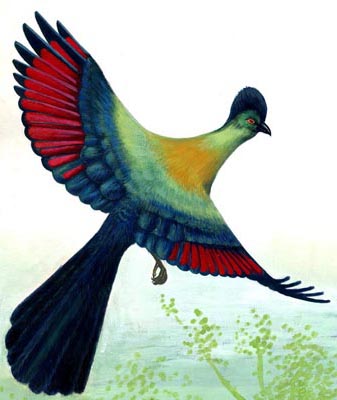The ENTC now has a new website, at www.entc.org.sz
Our logo is adapted from a painting by Phillip Dlamini, 1998, of a purple crested turaco. In traditional Swazi dress, the red feathers feature in the royal headdress, so this bird illustration is not only a symbol for wildlife conservation, but also of cultural heritage.


The Lubombo mountains were home to the prehistoric peoples of Africa. Early Stone Age tools and implements dating to one million years and beyond are found along the river beds and in the Lubombo ridges. In the eastern lowveld remains of Middle Stone Age peoples have been located some 50 to 100 thousand years old. Archaeological research has revealed that a complex of Stone Age cultures occupied the Mlawula and Siphiso Valleys over the last 30 thousand years. Evidence in the form of stone tools, bone remains, bead work, and early structures are found in the open, buried in alluvial and colluvial deposits, and in rock shelters.
(Contributed by Bob Forrester, December 2005)
The SARA team excavated all over Swaziland: near Ngwenya Mine, the Komati valley, the top of Sibebe, Nyonyane Shelter in Mlilwane and Siphiso Cave. During these excavations they were always looking for the one thing that archaeologists dream of: an undisturbed sequence of soils that has been deposited over time. In order to get a complete sequence of accurate dates it is critical to have layers of deposit, known as stratigraphy, that is intact. Disturbance can come from water running through the cave, people burying objects, animals (like moles) making tunnels and treasure seekers. It was Siphiso that provided them with the undisturbed sequence of soil deposits that they had spent so long searching for. The team then spent some five excavation seasons digging in the cave. They would excavate for about four months each year and then send the material to various universities to be analysed and dated for the rest of the time. During excavations they stayed at the SNTC's Mapelepele camp in Mlawula Nature Reserve.
The excavations were very successful. The team found ancient charcoal in the deposits that was in very good condition. They realized that not only could it be used to date the level that it was in by carbon dating, but it could also often be used to find out what tree species the burnt wood had come from. They were able to determine the species by taking scanning electron microscope photographs of the cell structure in the charcoal and then compare this with modern samples of carbonized wood. It was possible to get exact matches with several species.
This may not sound much, but it is important. If one can establish the tree species, then if you are lucky you may find that that particular species only grows within very narrow climatic conditions. Therefore once you have dated and identified a species you can potentially establish what the climate was like at a particular moment in time thousands of years ago. If you find that the types of trees burned in the cave varied over time, then you also have an indication of how the climate varied over time.
Dr Juliet Prior, a member of the SARA team, pioneered this technique worldwide and was able to identify a changing sequence of tree types burned in the cave together with the climatic conditions like maximum and minimum rainfall and temperatures that they would grow in. As a result the team was able to not only provide dates when people occupied the cave, but could also determine in broad terms how the climate had varied over time.
One of the species that they were able to identify with a narrow climatic range that it would tolerate was Androstachys johnsonii. This was extremely useful in determining when there was a mini ice age and the interior of the continent became cold. Early people then moved to the coastal plains in Mozambique just over the Lubombo mountains where the climate was warmed by the equatorial Mozambique current. When the cold phase ended they returned to Siphiso Cave. This pattern has since been identified all over southern Africa, but it was the excavations at Siphiso that first provided clear evidence of what was happening and why.
This research has become part of a much larger worldwide picture of changing climate over time, something that is critical when scientists are trying to determine the extent of global warming and the reasons for it happening.
Our Contacts:
Head Quarters: (+268) 2416 1489/1179
Email: info@sntc.org.sz
King Sobhuza II Park: (+268) 2416 1489/1179
Email: ksmp@sntc.org.sz
National Museum: (+268) 2416 1489/1179
Email: curator@sntc.org.sz
Copyright © ESWATINI NATIONAL TRUST COMMISSION
Malolotja Nature Reserve: (+268) 2444 3241 / (+268) 2416 1480
Email: culturalvillage@sntc.org.sz
Mantenga Nature Reserve and Swati Cultural Village: 2416 1151/1178
Email: culturalvillage@sntc.org.sz
Mlawula Nature Reserve: (+268) 2383 8885 (Reception)
(+268) 2383 8453 (Senior Warden)
Email: culturalvillage@sntc.org.sz
Magadzavane Lodge: (+268) 2343 5108/9
Email: magadzavane@sntc.org.sz